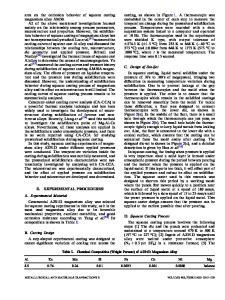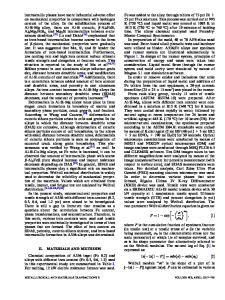Microstructure and Properties of A356 Alloy Wheels Fabricated by Low-Pressure Die Casting with Local Squeeze
- PDF / 3,210,661 Bytes
- 10 Pages / 593.972 x 792 pts Page_size
- 43 Downloads / 318 Views
JMEPEG https://doi.org/10.1007/s11665-019-03993-5
Microstructure and Properties of A356 Alloy Wheels Fabricated by Low-Pressure Die Casting with Local Squeeze Jia-Min Huang, Hai-Dong Zhao, and Zhen-Ming Chen (Submitted June 3, 2018; in revised form January 29, 2019) The low-pressure die-casting process (LPDC) is widely used in fabricating aluminum alloy automotive wheels. With good castability and mechanical properties, A356 alloys are important and common materials for LPDC wheels. However, in practical casting process, defects often appear, especially porosities in the wheel thick-walled parts (i.e., spoke) due to inadequate interdendritic feeding, which greatly decreases the mechanical properties. In this investigation, to deal with this problem, local squeeze (LS) was added in conventional LPDC to enhance the interdendritic feeding. The practical A356 alloy wheel castings were fabricated with different LS velocities and times. The quantitative characteristics of a-Al cells, Si particles, and porosities with and without the LS analyzed by optical microscope, scanning electron microscope, and 3D x-ray computed tomography were compared. Their effects on the tensile and impact properties were discussed. The results have shown that the LS can increase the cooling rate and feed shrinkage of spoke parts, hence resulting in finer grains and denser microstructure. In result, the properties of spoke parts were improved with the LS. Keywords
A356, low-pressure die casting, local squeeze, wheel
1. Introduction At present, about 80% of aluminum alloy wheels are being made by low-pressure die-casting (LPDC) process, which is a relatively simple and automatic process meeting requirements of performance, production cost, and complex structure. For the LPDC wheels, A356 alloy is the most used material due to its excellent castability, corrosion resistance, and mechanical properties. The alloy microstructures are consisted of a-Al cells and eutectics. Their characteristics have important effect on the alloy mechanical properties. Ali (Ref 1) found that the cooling rate had a direct effect on the size and distribution of microstructural phases in a casting and, in turn, on the impact toughness as well. With computer technique, Mohsen (Ref 2) used finite element technique and artificial neural network to predict the microstructure of A356 according to cooling rate. Also, Mohsen (Ref 3) studied the correlation between yttriummodified microstructure and mechanical properties and pointed out that high cooling rate scaled down the dimensions of the Si particles and improved the mechanical properties; the volume fraction of porosity was controlled to some extent by the solidification rate. It is shown that a-Al and Al-Si eutectic are the common phases of A356 and that the mechanical properties of Al-Si alloys can be controlled by the individual physical
Jia-Min Huang, Hai-Dong Zhao, and Zhen-Ming Chen, Guangdong Key Laboratory for Processing and Forming of Advanced Metallic Materials, South China University of Technology, Guangzhou 51064
Data Loading...











